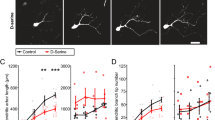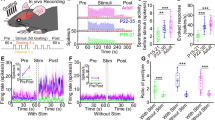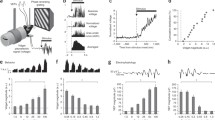Abstract
The effect of intracortical perfusion with the glutamate agonist NMDA on visual recognition and short-term memory, as well as on the responses of visual cortex neurons, were studied in rhesus macaques. A microdialysis technique was used in combination with multichannel microelectrode recording of single cortical cells in the immediate vicinity of the dialysis tube in a behavioral experiment in which the monkey had to solve a task involving delayed visual differentiation of stimuli of different colors. NMDA altered the characteristics of recognition in monkeys. The duration of information storage in short-term memory was increased significantly (2–4-fold), and there was a significant reduction in the motor response time for all delay periods. These changes were accompanied by a significant rearrangement of neuron activity in the visual cortex at all stages of the behavioral task. At different stages of the task, 70–85% of the neurons showed 2–5-fold increases in activity, while 6–20% showed reductions in activity. These results demonstrate an involvement of visual cortex glutaminergic structures in the processes of visual recognition and short-term memory, as well as a nootropic effect obtained by intracortical administration of NMDA.
Similar content being viewed by others
References
E. B. Burlakova, “The role of synaptic membrane lipids in the transmission and storage of information,” in: Studies of Memory [in Russian], Moscow (1990), pp. 146–153.
S. A. Dambinova, Glutamate Neuroreceptors [in Russian], Leningrad (1989).
K. N. Dudkin, Visual Perception and Memory [in Russian], Leningrad (1989).
K. N. Dudkin, V. K. Kruchinin, Yu. V. Skryminskii, and I. V. Chueva, Methods for the Automated Study of Neuronal Mechanisms of Behavior [in Russian], Leningrad (1989).
K. N. Dudkin, V. K. Kruchinin, and I. V. Chueva, “The process of visual recognition in monkeys and their neuronal correlates in the visual cortex: the effect of M-cholinoreceptor blockers,” Fiziol. Zh. im. I. M. Sechenova,78, No. 10, 36–43 (1992).
K. N. Dudkin, V. K. Kruchinin, and I. V. Chueva, “Antioxidant-elicited improvements in cognitive characteristics in monkeys: neurophysiological correlates in the visual cortex,” Fiziol. Zh. im. I. M. Sechcnova,78, No. 12, 78–87 (1992).
K. N. Dudkin, V. K. Kruchinin, I. V. Chueva, et al., “Microanalytical methods for the cerebral cortex in studies of neurophysiological correlates of recognition processes in monkeys,” Fiziol. Zh. im. I. M. Sechenova,80, No. 10, 128–132 (1984).
S. N. Olenev, The Construction of the Brain [in Russian], Leningrad (1987).
O. M. Samoilov, “The role of calcium in mechanisms of cholinergic and glutaminergic signal transduction in the central nervous system,” Zh. Évolyuts. Biokhim. Fiziol.,28, No. 2, 13–27 (1992).
V. M. Storozhuk, S. F. Ivanova, and A. V. Sanzharovskii, “The involvement of glutamate intracortical connections in conditioned reflex activity,” Neirofiziologiya,24, No. 6, 701–712 (1992).
R. C. Boldry and N. J. Uretsky, “The importance of dopaminergic neurotransmission in the hypermotility response produced by the administration of N-methyl-D-aspartic acid into the nucleus accumbens,” Neuropharmacology,27, 569–577 (1988).
M. B. Bronberg, J. B. Penney, B. S. Stephenson, and A. B. Young, “Evidence for glutamate as the neurotransmitter of corticothalamic and corticorubral pathways,” Brain Res.,215, No. 1-2, 369–374 (1981).
B. A. Donzanti and N. J. Uretsky, “Magnesium selectively inhibits N-methyl-D-aspartic acid-induced hypermotility after intra-accumbens injection,” Pharmacol. Biochem. Behav.,20, 243–246 (1984).
P. Joelet, V. F. Castellucci, S. Schachter, and E. R. Kandel, “The long and short of long-term memory: a molecular framework,” Nature,322, 420–423 (1986).
E. R. Kandel, “Calcium and the control of synaptic strength by learning,” Nature,293, 697–700 (1981).
M. B. Kennedy, “Regulation of synaptic transmission in the central nervous system: long-term potentiation,” Cell,59, 777–787 (1989).
J. Lincoln, R. Coopersmith, E. W. Harris, et al., “NMDA receptor activation and early olfactory learning,” Dev. Brain Res.,39, 309–312 (1988).
G. Lynch, J. Larson, U. Staubli, and R. Grander, “Variants of synaptic potentiation and different types of memory operations in the hippocampus and related structures,” in: Memory: Organization and Locus of Change, L. R. Sguire et al. (eds.) (1991), pp. 330–363 [sic].
G. Lynch and M. Baudry, “The biochemistry of memory: a new and specific hypothesis,” Science,224, No. 4653, 1057–1063 (1984).
K. D. Miller, B. Chapman, and M. P. Stryker, “Visual responses in adult cat visual cortex depend on N-methyl-D-aspartate receptors,” Proc. Natl. Acad. Sci. USA,86, 5183–5187 (1989).
M. J. Pontecorvo and D. B. Clissold, “NMDA antagonism and working memory performance,” Soc. Neurosci. Abstr.,14, 248 (1988).
W. Singer, “The formation of cooperative cell assemblies in the visual cortex,” Exper. Biol.,153, 177–197 (1990).
Y. Tsukuda, “Molecular approaches to learning and memory,” Jpn. J. Physiol.,38, 115–132 (1988).
T. Tsumoto, K. Hagihara, H. Sato, and I. Hata, “NMDA receptors in the visual cortex of young kittens are more effective from those of adult cats,” Nature,327, 513–514 (1987).
J. T. Wroblewski and W. Danysz, “Modulation of glutamate receptors: molecular mechanisms and functional implications,” Ann. Rev. Pharmacol. Toxicol.,29, 441–74 (1989).
Additional information
Laboratory for the Regulation of Brain Neuron Function (Director M. O. Samoilov), I. P. Pavlov Institute of Physiology, Russian Academy of Sciences, St. Petersburg. Translated from Fiziologicheskii Zhurnal imeni I. M. Sechenova, Vol. 81, No. 5, pp. 23–30, May, 1995.
Rights and permissions
About this article
Cite this article
Dudkin, K.N., Kruchinin, V.K. & Chueva, I.V. Effect of NMDA on the activity of cortical glutaminergic structures in delayed visual differentiation in monkeys. Neurosci Behav Physiol 27, 153–158 (1997). https://doi.org/10.1007/BF02461946
Received:
Issue Date:
DOI: https://doi.org/10.1007/BF02461946




